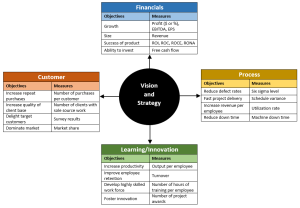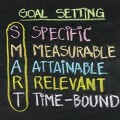
The Balanced Scorecard is a system for the implementation of corporate strategy. It is a performance measurement tool that helps an organization execute its strategies and turn them into measurable results “on the ground.” In its practical form, a balanced scorecard is a 4-quadrant itemized list of key performance indicators (KPI’s) that the organization strives to meet.
The overall principle of the balanced scorecard is to move executive’s thinking away from pure financial results and more toward a balanced portfolio of business performance metrics. Essentially, if you become the best at all four of the categories, you will produce greater success than simply focusing on financials. The following four general categories are used:
- Customer
- Process
- Financial
- Learning/Innovation
Customer
As the founder/principle of an engineering company, I’ve stated to my staff many times that if we focus on making our customers happy, the financials will take care of themselves. When I say this I’m in the customer quadrant – I’m looking at the business through the eyes of the customers. From that focus are one can brainstorm things like what the meaning of happy customers actually is, and what specific things can be done to get more of them. You can develop the KPI’s of your business as it relates to customers. Some text books state it as the following question:
To achieve our vision, how must we appear to our customers?
Here are a few examples of KPI’s in this category.
| Objectives | KPI’s |
|---|---|
| Increase repeat purchases | Number of purchases per customer |
| Increase quality of client base | Number of clients with sole source work |
| Delight target customers | Survey results |
| Dominate market | Market share |
Process
You could also focus on the process, i.e. If you make the best/fastest/coolest widgets, the financials will take care of themselves.
In this quadrant, you look at the business through the eyes of its processes. Quality, timeliness, and output volumes are important considerations. Where can business processes be improved and what new processes can be introduced to provide competitive advantage? Even if you don’t work in an industry where the big differentiator is the product, I can’t think of a case where this isn’t an important consideration.
To achieve our vision, which business processes must we excel at?
| Objectives | KPI’s |
|---|---|
| Reduce defect rates | Six sigma level |
| Faster project delivery | Schedule variance |
| Increase Revenue per employee | Utilization rate |
| Reduce downtime | Machine downtime |
Financial
Although the balanced scorecard is meant to replace pure financial objectives as the focus of management’s attention, financial metrics still have their place among the other three as a focus area. This category represents the traditional way of looking at the business.
In the public sector this quadrant is sometimes replaced with “Performance” emphasizing the value the organization provides to its taxpayers/users.
To achieve our financial goals, how should we appear to our shareholders?
| Objectives | KPI’s |
|---|---|
| Growth | profit ($ or %), EBITDA, EPS |
| Size | revenue |
| Success of product | ROI, ROC, ROCE, RONA |
| Ability to invest | Free cash flow |
Learning/Innovation
Lastly, the focus of the business can be on the progress of knowledge and innovation. This includes much more than just training people.
- Organizational learning, such as the establishment of new ways of doing things due to the acquisition of knowledge. New processes, decision making frameworks, strategies, projects, etc. will improve the bottom line when the organization moves forward with training programs.
- Strategic investments in processes, people, information systems and organizational culture result in improvements to the bottom line.
- Motivation and creativity due to forward moving, change focused ideas.
- Innovation on the project and process level which causes increased client and customer satisfaction.
To achieve our vision, how will we sustain our ability to change and improve?
| Objectives | KPI’s |
|---|---|
| Increase productivity | Output per employee |
| Improve employee retention | Turnover |
| Develop highly skilled workforce | Number of hours of training per employee |
| Foster innovation | Number of project awards |
Balanced Scorecard Example
Please see our Balanced Scorecard template. It’s in MS Word so you can insert your own KPI’s or use it as a starting point. You are free to use, abuse, and distribute this file as you wish. There are no restrictions. All I ask is that you let me know in the comments if there’s something I missed, so that I can update it and the world can have an awesome crowd-sourced template.











Leave a Reply